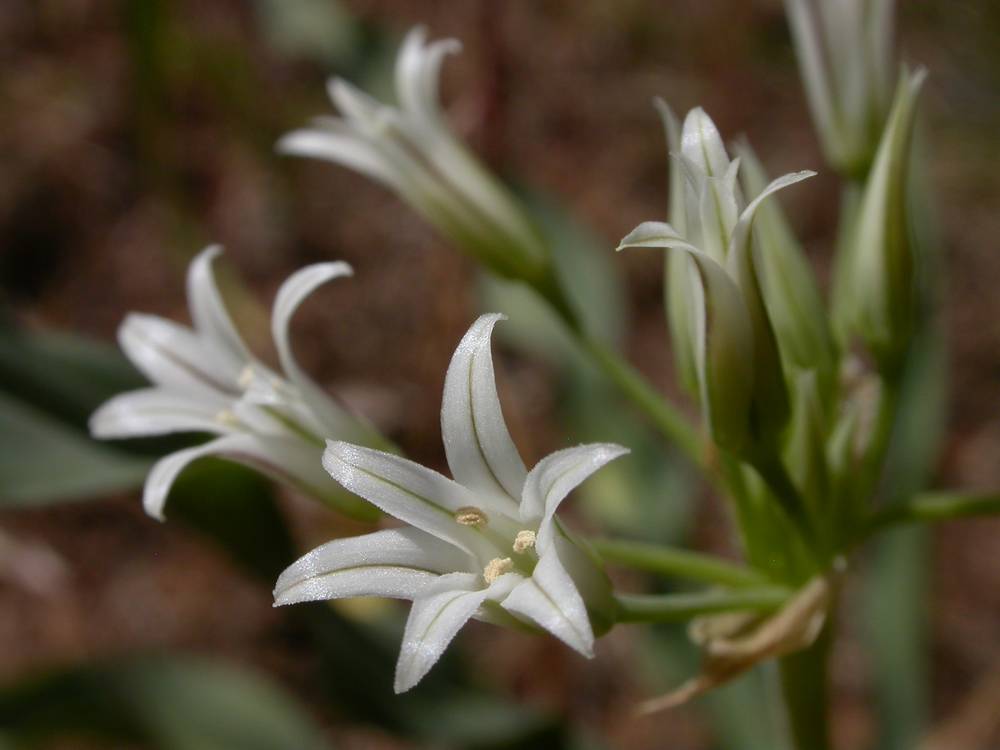
Bulbs 1–6+, not basally clustered, new bulbs borne terminally on rhizomes; rhizomes 1–3, slender, less than 2 cm long including renewal bulb; parent bulbs disappearing by anthesis except for still-functional roots and bulb coat, oblique-ovoid to more or less oblong; outer coats not enclosing bulbs, more or less obscurely reticulate, membranous, reticulum delicate, cells transversely elongate, V-shaped or more or less wavy, forming obscure herringbone pattern, without fibers.
Leaves persistent, withering from tip at anthesis, 2–3; blades solid, subterete to more or less channeled, 9–30 cm × 1–2 mm.
Scapes persistent, solitary, erect, solid, terete, 10–35 cm × 1–3 mm.
Umbels persistent, erect, compact to loose, 10–20-flowered, hemispheric; pedicels 10–20 mm; spathe bracts 2.
Flowers 7–14 mm; tepals erect, narrowly lanceolate to lance-ovate, more or less equal, reddish purple, rarely white, margins finely denticulate (inner tepals more prominently so), apex acute to obtuse, becoming involute at tip and appearing acuminate; stamens included; ovary obscurely crested with 3 minute processes; stigma scarcely thickened, obscurely 3-lobed.
2n=14.
Clay soils, usually on serpentine, dry openings and savanna.
2 varieties. The varieties of A. bolanderi are extremely difficult to distinguish in the absence of bulb material. Although great care must be taken to obtain good bulbs whenever collecting any Allium taxon, it is especially critical within this species.
as described under Allium bolanderi
Bulbs 1-6+, not basally clustered, replaced annually by new bulbs borne terminally on rhizomes; rhizomes 1-3, inconspicuous, slender, less than 2 cm including renewal bulb; parent bulbs disappearing by anthesis except for still-functional roots and bulb coat, oblique-ovoid to ± oblong, 0.7-1.4 × 0.5-1.2 cm; outer coats not enclosing bulbs, brown to gray-brown, ± obscurely reticulate, membranous, reticulum delicate, cells transversely elongate, V-shaped or ± wavy, forming obscure herringbone pattern, without fibers; inner coats white, cells obscure, quadrate to ± rectangular, often contorted. Leaves persistent, withering from tip at anthesis, 2-3, basally sheathing, sheaths not extending much above soil surface; blade solid, subterete to ± channeled, 9-30 cm × 1-2 mm, margins entire. Scape persistent, solitary, erect, solid, terete, 10-35 cm × 1-3 mm. Umbel persistent, erect, compact to loose, 10-20-flowered, hemispheric, bulbils unknown; spathe bracts persistent, 2, 4-6-veined, lanceolate to lance-ovate, ± equal, apex acuminate. Flowers conic to campanulate, 7-14 mm; tepals erect, reddish purple, rarely white, narrowly lanceolate to lance-ovate, ± equal, becoming rigid and carinate in fruit, margins finely denticulate (inner tepal more prominently so), apex acute to obtuse, becoming involute at tip and appearing acuminate; stamens included; anthers yellow; pollen yellow; ovary crested; processes 3, central, 2-lobed, minute, margins entire; style linear, equaling stamens; stigma capitate, obscurely 3-lobed, scarcely thickened; pedicel 10-20 mm. Seed coat dull; cells minutely roughened.The varieties of Allium bolanderi are extremely difficult to distinguish in the absence of bulb material. Care must be taken to obtain good bulb material whenever collecting Allium, but it is extremely critical in this species.